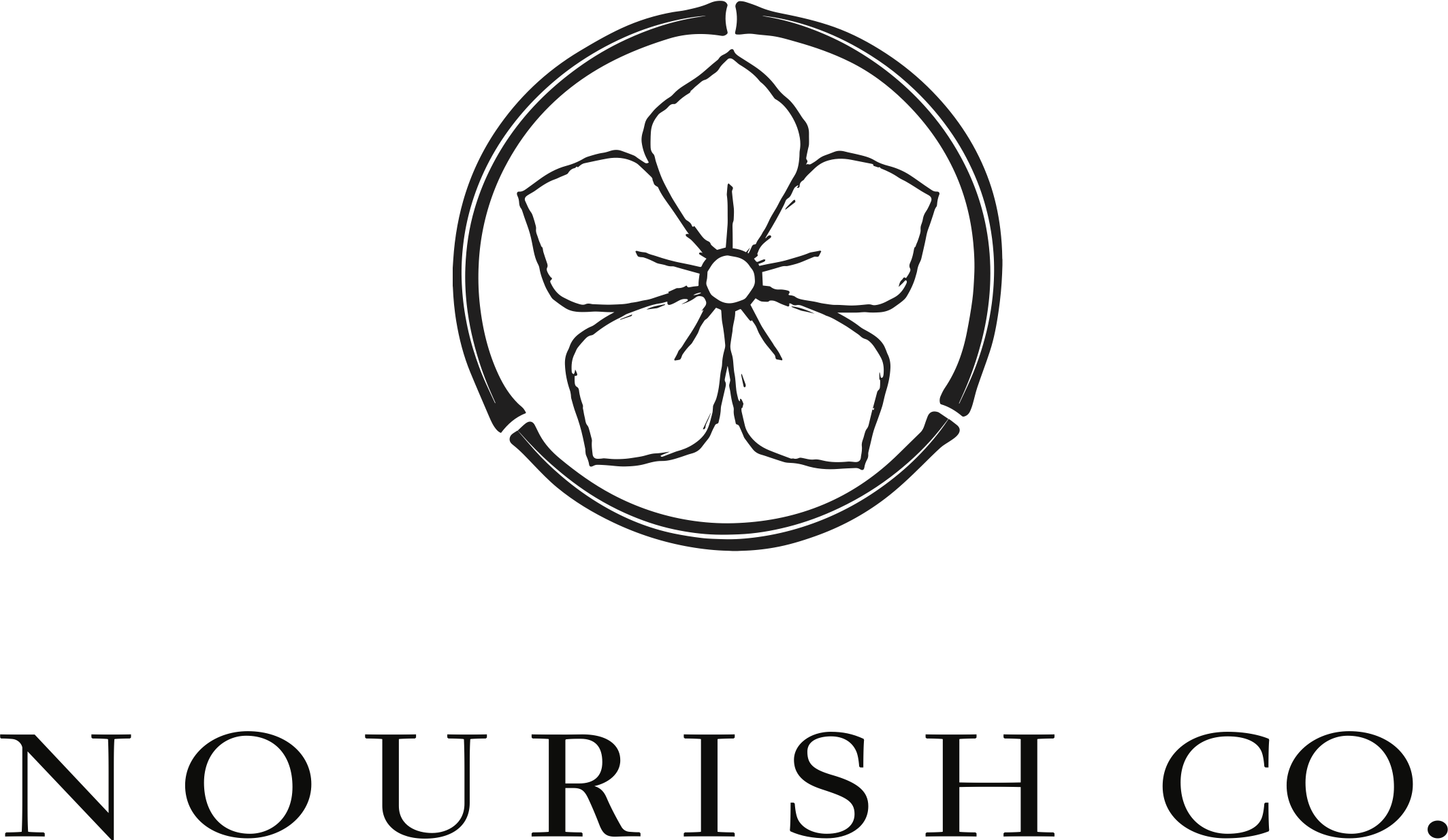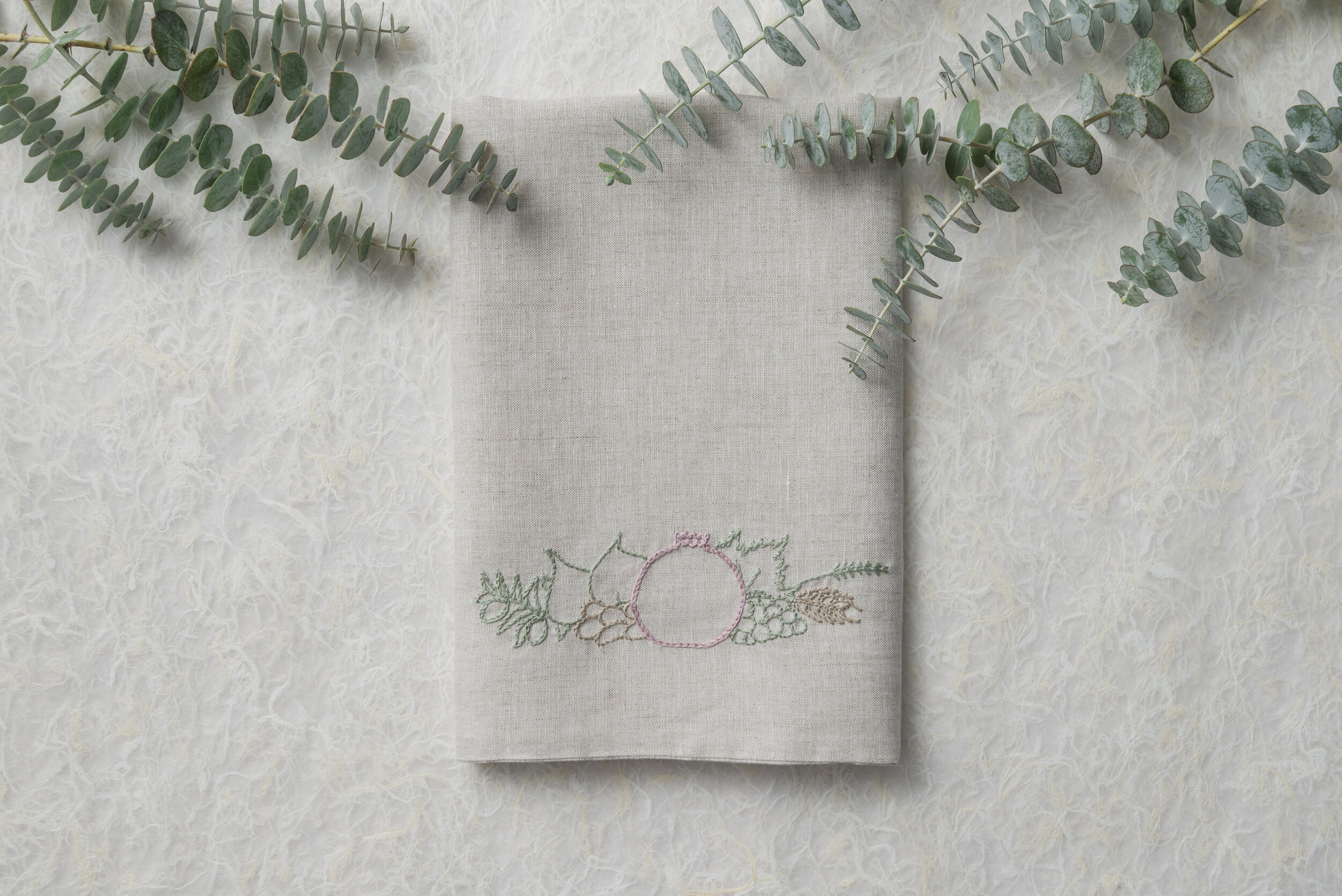Nourish Co. Challah Cover Collaboration: An Interview with Broiderie Stitch
The Nourish Co. Challah Cover is a collaboration with New England hand-embroidery studio, Broiderie Stitch. Only a limited supply is available. Get yours here.
This is the challah cover I’ve been dreaming of for years! Challah covers are special cloths used to cover braided challah bread, which is blessed before the Jewish Shabbat meal. They are often machine-embroidered elaborately on linen or silk, with the words “Shabbat Shalom” written in Hebrew. I wanted to create a very pared-back, contemporary design of the Biblical Seven Species. It was also important to me to not include any words, so that this heirloom could be multi-purposed: It can be used for Shabbat of course, but it can also be used on other Jewish holidays, as a tea towel, or by people who don’t identify as Jewish, but might have a connection with the Biblical Seven Species. These sacred species are listed in the Torah as being grown and consumed during Biblical times: Wheat, barley, grapes, figs, pomegranates, olives, and dates. Jewish mystics have attributed spiritual energies to the medicinal properties of each of the seven species.
Each challah cover is made entirely by hand by a team of artisans in New England. Broiderie Stitch is proudly 100% carbon neutral, and is dedicated to preserving the craft and heritage of hand embroidery for generations to come. I feel incredibly lucky to have connected with Jackie Frost, Broiderie Stitch’s visionary founder, and am delighted to share her story below.
Nourish Co.: How did you begin embroidery? Did anyone in your family sew or teach you?
Jackie Frost: My mother taught me the basics of sewing when I was four years old. One of my stuffed animals had a hole in it, and I was determined to fix it on my own. I should have stayed still for a longer lesson; I did a terrible job on that poor caterpillar! Then I hid away some thread and a needle so I could keep stitching and trying to plait the threads into lace. Mom must have noticed my interest or the missing supplies, because I got my first embroidery kit soon after. I didn’t follow those directions any better than I did hers, but I loved the rich colors. I picked up knitting, weaving, crochet, and quilting in my early years as well so there are plenty of truly terrible scarves and dish towels scattered throughout my family.
NC: Your business flourished out of a great struggle, and then your craft began to sustain you. Can you talk more about this stroke of good luck and do you think you were almost destined to do embroidery as your life’s work?
JF: I stitched throughout my childhood, but I never anticipated it becoming my career. I went to school for botany, and in my free time I would stitch botanical drawings onto book covers and research different types of embroidery from around the world. It was my future mother-in-law who encouraged me to sell my work, and although I thought she was crazy, we were pretty desperate. Those first orders were the only thing that put food on the table for a few weeks until things got sorted out. Before I knew it I was spending more time embroidering than working at my other job and we saved up enough money to move back home. By then the shop kept me occupied full-time, and it’s been my career ever since. It’s grown enough that I’ve taken on employees— Karen and Steven make our items on the sewing machine and Jen, my mother, and I embroider them. Mom is very proud of her early involvement and often pops in to drop off an order and give a few tips.
I learned many of my crafts from family members and I think of them whenever I use their special techniques or tools. I recently found out that a few of my ancestors were lacemakers in London in 1802, so it does feel like I’m carrying on a tradition in a way. Two of them made lace and one of them was a lace cutter— the one who would assemble motifs into a coherent whole and cut out and repair any mistakes. What a job! I can’t imagine taking scissors to lace that someone had spent so many hours on, especially with them nearby. She must have had nerves of steel.
NC: Can you talk a little bit about other embroiderers who inspire you?
JF: I wish I knew more embroiderers locally. The closest one I know that makes her living with embroidery is Mary Corbet in Kansas. She works in a variety of styles and her pieces are often influenced by historical works, especially ecclesiastical ones. She runs a wonderful blog about her projects and sells patterns and kits there as well. Her articles on techniques, materials, and stitches are a wonderful resource. Another very prominent woman in the field is Trish Burr; she’s from South Africa. She specializes in needlepainting, a very realistic form of embroidery that uses stitches almost like a painter’s brushstrokes. She’s been busy putting her own spin on whitework embroidery too. She has an incredible grasp of color theory and how it relates to embroidery. I consider her one of the finest stitchers working in needlepainting today.
NC: What steps have you taken to become carbon-neutral? How did you decide to make this a priority in your business?
JF: Studying for years in environmental sciences really opened my eyes to just how far-reaching our impact on the planet has been. One of the ways we’ve been able to lessen our footprint is by going carbon neutral – carbon negative, really. We calculated the amount of carbon produced from shipping an average order as well as how many we make in a year, making sure to add plenty of room for growth. Then we figured out how many trees it would take to sequester ten year’s worth of carbon from our orders and sent the money for them to the National Forest Foundation. They work incredibly hard to reforest after fires and create and maintain habitat for at-risk species. Somewhere in the Southwest there’s a little grove planted because of Broiderie Stitch and I plan to do as much or more every year. Etsy has recently gone carbon-neutral for all orders as well.
We’re also working on producing zero waste in the studio; that’s a bit more hands-on at our end. We use the thread snips left over from sewing to make the centers of our temari balls; they’re a traditional and soft filling. We save the linen scrap from cutting our items to make quilts, and we recycle what packaging we receive and the paper we produce. I’d like to have a compost pile to take care of the spent tea leaves and the dust from sweeping up, but that’s not an option quite yet. We try to do our part with more subtle decisions, too. We use only linen fabric in the shop; since it’s more durable than cotton it lasts longer and less ends up in landfills. Linen uses less pesticide and can grow on more marginal land than cotton does, and it creates more jobs per acre because it’s less amenable to industrialization, too.
NC: You’ve mentioned that supporting a small business can stem the tide of forgetting. What do you see for the future of one-of-a-kind craftsmanship and art forms? What do you hope to see when it comes to preserving traditions and unique skills like yours?
JF: Sometimes I worry that we don’t have enough free time to really pursue hobbies, and so I fear that not enough people will be able to dedicate the time and energy to honing a craft in the manner that used to be commonplace. Small embroidery studios used to be fairly common in the U.S, but most of them died out by the 1950s due to industrialization or because they just couldn’t reach a wide enough audience with mailed catalogs. However, the internet is rapidly changing things. Now, little shops like mine that could never support themselves locally can find a worldwide audience online. Purchasing from a small business not only allows for better craftsmanship but increases the pool of knowledge about a certain art, since more people are involved in creating it. More people means more unique creations as well, so you’re more likely to find just what you’re looking for. I’ve found that there’s a general trend away from the mass-market and towards smaller, more ethical businesses.
I’m pretty optimistic about preserving art forms and skills, actually. At no time in human history have we had such a collection of knowledge just a click away. Sites like the Antique Pattern Library and Project Gutenburg have been instrumental in my research and I am indebted to the volunteers that keep them running. Social sites allow people to share projects, patterns, and ideas with the world and the spread of information lets techniques catch on like wildfire. I think the embroiderers of the past would love to see how much we can connect and just how much we can learn from each other, online.
Thanks so much, Jackie! It has been an honor and such a pleasure collaborating with you.
Only a few of these limited-release challah covers were created, so be sure to purchase one before they’re all gone! Once they are gone, this exact design will never be produced again; the beauty of handmade in small batches.
To shop the challah cover, head here.
To read more about the other makers in the Nourish Co. Heirloom shop, head here.






